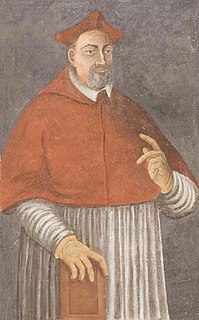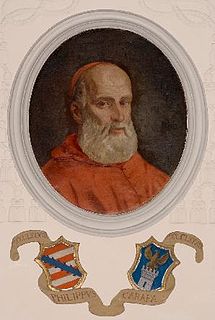
The 1878 papal conclave, which resulted from the death of Pope Pius IX on 7 February 1878, met from 18 to 20 February. The conclave followed the longest reign of any other pope since Saint Peter. It was the first election of a pope who would not rule the Papal States. It was the first to meet in the Apostolic Palace in the Vatican because the venue used earlier in the 19th century, the Quirinal Palace, was now the palace of the King of Italy, Umberto I.

The Congregation of Clerics Regular, commonly called the Theatines, is an order of clerics regular of Pontifical Right for Men of the Catholic Church. It was founded by Archbishop Gian Pietro Carafa in Sept. 14, 1524. Its members add the nominal letters C.R. after their names to indicate their membership in the Congregation.

Alessandro Farnese, an Italian cardinal and diplomat and a great collector and patron of the arts, was the grandson of Pope Paul III, and the son of Pier Luigi Farnese, Duke of Parma, who was murdered in 1547. He should not be confused with his nephew, Alessandro Farnese, Governor of the Spanish Netherlands, grandson of Emperor Charles V and great-grandson of Pope Paul III.
A doctor of both laws, from the Latin doctor utriusque juris, or juris utriusque doctor, or doctor juris utriusque is a scholar who has acquired a doctorate in both civil and church law. The degree was common among Roman Catholic and German scholars of the Middle Ages and early modern times. Today the degree is awarded by the Pontifical Lateran University after a period of six years of study, by the University of Würzburg, and by the University of Fribourg.

Oliviero Carafa, in Latin Oliverius Carafa, was an Italian cardinal and diplomat of the Renaissance. Like the majority of his era's prelates, he displayed the lavish and conspicuous standard of living that was expected of a prince of the Church. In his career he set an example of conscientiousness for his contemporaries and mentored his relative, Giovanni Pietro Carafa, who was also "Cardinal Carafa" from 1536 to 1555, when he became Pope Paul IV.

The Roman Catholic Suburbicarian Diocese of Ostia is an ecclesiatical territory located within the Metropolitan City of Rome in Italy. It is one of the seven suburbicarian dioceses. The incumbant Bishop is cardinal Giovanni Battista Re. Since 1150, its bishop has been the Dean of the College of Cardinals, Its Cathedral is Basilica di Sant'Aurea.

Scipione Rebiba was an Italian prelate of the Catholic Church, a protégé of Gian Pietro Carafa, who became Pope Paul IV. He held a variety of positions in the Church hierarchy, including some of the most senior. He introduced the Inquisition to Naples in the 1550s and became a cardinal in 1555. He is mostly known today for having been the earliest bishop to whom most Roman Catholic bishops can trace their apostolic succession, as it is unknown who consecrated Rebiba.

The Diocese of Aversa is a Roman Catholic ecclesiastical territory in Campania, southern Italy, created in 1053. It is situated in the Terra di Lavoro (Liburia), seven miles north of Naples, and eight miles south of Capua. It is suffragan of the Archdiocese of Naples.

The Diocese of Cassano all'Jonio is a Roman Catholic diocese in Calabria.

The Diocese of Frascati is a suburbicarian see of the Holy Roman Church and a diocese of the Catholic Church in Italy, based at Frascati, near Rome. The bishop of Frascati is a Cardinal Bishop; from the Latin name of the area, the bishop has also been called Bishop of Tusculum. Tusculum was destroyed in 1191. The bishopric moved from Tusculum to Frascati, a nearby town which is first mentioned in the pontificate of Pope Leo IV. Until 1962, the Cardinal-Bishop was concurrently the diocesan bishop of the see in addition to any curial duties he possessed. Pope John XXIII removed the Cardinal Bishops from any actual responsibility in their suburbicarian dioceses, and made the title purely honorific.

Carlo Carafa of a distinguished family of Naples, vicious and talented was successively condottiero in the service of France and of Spain, vying for their protectorates in Italy until 1555, when he was made a cardinal, to 1559 the all-powerful favourite and Cardinal Nephew of Pope Paul IV Carafa, whose policies he directed and whom he served as papal legate in Paris, Venice and Brussels. According to the Jesuit, later Cardinal, Francesco Sforza Pallavicino, writing the history of the Council of Trent, his subtlety of spirit and grace of address, physical courage and instinct for glory were overridden by his insatiable thirst for power.

Francesco Pisani was an Italian Cardinal, born in Venice, the son of Alvise Pisani the noted banker, who was Procurator of S. Mark's, a member of the Council of Ten, and a Councilor of the Doge of Venice; and Cecilia Giustinian. He had a brother named Giovanni (Zuan), who also became Procurator of S. Marks' and was a Venetian diplomat; he was married to the sister of Doge Andrea Gritti. He was a strong supporter of the alliance between Venice, France and the Papacy, called the League of Cognac. He shared the imprisonment of Pope Clement VII in the Castel S. Angelo during the Sack of Rome and its aftermath. He spent eighteen months in exile in Naples while Clement made his peace with the Emperor Charles V.

Pierluigi Carafa, Junior was an Italian cardinal from the famous Neapolitan family of Italian nobles, clergy, and men of arts. He served the papacy as Camerlengo of the Sacred College of Cardinals and as Dean of same College. He is currently buried at Sant'Andrea delle Fratte in Rome.

Domenico Carafa della Spina di Traetto was a Catholic Cardinal, Archbishop of Benevento and Camerlengo of the Sacred College of Cardinals.

The House of Carafa or Caraffa is a noble Neapolitan family of Italian nobles, clergy, and men of arts, known from the 12th century.

Pier Luigi Carafa (Senior) was a cardinal of the Catholic Church, and a member of the Roman Curia.

The 1559 papal conclave was convened on the death of Pope Paul IV and elected Pope Pius IV as his successor. Due to interference from secular rulers and the cardinals' disregard for their supposed isolation from the outside world, it was the longest conclave of the 16th century.

Amico Agnifili was an Italian Roman Catholic bishop and cardinal.

Filippo Carafa della Serra was an Italian Cardinal of the Roman Catholic Church.


















